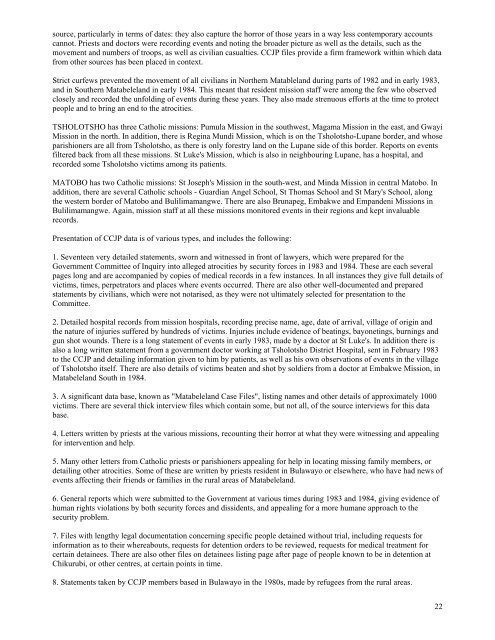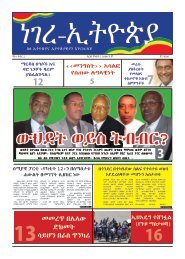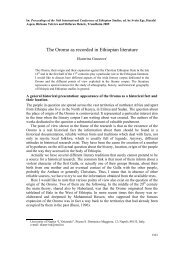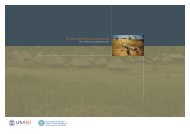MatabelelandReport
MatabelelandReport
MatabelelandReport
Create successful ePaper yourself
Turn your PDF publications into a flip-book with our unique Google optimized e-Paper software.
source, particularly in terms of dates: they also capture the horror of those years in a way less contemporary accounts<br />
cannot. Priests and doctors were recording events and noting the broader picture as well as the details, such as the<br />
movement and numbers of troops, as well as civilian casualties. CCJP files provide a firm framework within which data<br />
from other sources has been placed in context.<br />
Strict curfews prevented the movement of all civilians in Northern Matableland during parts of 1982 and in early 1983,<br />
and in Southern Matabeleland in early 1984. This meant that resident mission staff were among the few who observed<br />
closely and recorded the unfolding of events during these years. They also made strenuous efforts at the time to protect<br />
people and to bring an end to the atrocities.<br />
TSHOLOTSHO has three Catholic missions: Pumula Mission in the southwest, Magama Mission in the east, and Gwayi<br />
Mission in the north. In addition, there is Regina Mundi Mission, which is on the Tsholotsho-Lupane border, and whose<br />
parishioners are all from Tsholotsho, as there is only forestry land on the Lupane side of this border. Reports on events<br />
filtered back from all these missions. St Luke's Mission, which is also in neighbouring Lupane, has a hospital, and<br />
recorded some Tsholotsho victims among its patients.<br />
MATOBO has two Catholic missions: St Joseph's Mission in the south-west, and Minda Mission in central Matobo. In<br />
addition, there are several Catholic schools - Guardian Angel School, St Thomas School and St Mary's School, along<br />
the western border of Matobo and Bulilimamangwe. There are also Brunapeg, Embakwe and Empandeni Missions in<br />
Bulilimamangwe. Again, mission staff at all these missions monitored events in their regions and kept invaluable<br />
records.<br />
Presentation of CCJP data is of various types, and includes the following:<br />
1. Seventeen very detailed statements, sworn and witnessed in front of lawyers, which were prepared for the<br />
Government Committee of Inquiry into alleged atrocities by security forces in 1983 and 1984. These are each several<br />
pages long and are accompanied by copies of medical records in a few instances. In all instances they give full details of<br />
victims, times, perpetrators and places where events occurred. There are also other well-documented and prepared<br />
statements by civilians, which were not notarised, as they were not ultimately selected for presentation to the<br />
Committee.<br />
2. Detailed hospital records from mission hospitals, recording precise name, age, date of arrival, village of origin and<br />
the nature of injuries suffered by hundreds of victims. Injuries include evidence of beatings, bayonetings, burnings and<br />
gun shot wounds. There is a long statement of events in early 1983, made by a doctor at St Luke's. In addition there is<br />
also a long written statement from a government doctor working at Tsholotsho District Hospital, sent in February 1983<br />
to the CCJP and detailing information given to him by patients, as well as his own observations of events in the village<br />
of Tsholotsho itself. There are also details of victims beaten and shot by soldiers from a doctor at Embakwe Mission, in<br />
Matabeleland South in 1984.<br />
3. A significant data base, known as "Matabeleland Case Files", listing names and other details of approximately 1000<br />
victims. There are several thick interview files which contain some, but not all, of the source interviews for this data<br />
base.<br />
4. Letters written by priests at the various missions, recounting their horror at what they were witnessing and appealing<br />
for intervention and help.<br />
5. Many other letters from Catholic priests or parishioners appealing for help in locating missing family members, or<br />
detailing other atrocities. Some of these are written by priests resident in Bulawayo or elsewhere, who have had news of<br />
events affecting their friends or families in the rural areas of Matabeleland.<br />
6. General reports which were submitted to the Government at various times during 1983 and 1984, giving evidence of<br />
human rights violations by both security forces and dissidents, and appealing for a more humane approach to the<br />
security problem.<br />
7. Files with lengthy legal documentation concerning specific people detained without trial, including requests for<br />
information as to their whereabouts, requests for detention orders to be reviewed, requests for medical treatment for<br />
certain detainees. There are also other files on detainees listing page after page of people known to be in detention at<br />
Chikurubi, or other centres, at certain points in time.<br />
8. Statements taken by CCJP members based in Bulawayo in the 1980s, made by refugees from the rural areas.<br />
22







